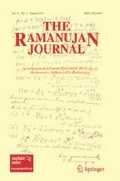Abstract
By studying non-commutative series in an infinite alphabet, we introduce shift-plethystic trees and a class of integer compositions as new combinatorial models for the Rogers–Ramanujan identities. We prove that the language associated to shift-plethystic trees can be expressed as a non-commutative generalization of the Rogers–Ramanujan continued fraction. By specializing the non-commutative series to q-series, we obtain new combinatorial interpretations of the Rogers-Ramanujan identities in terms of signed integer compositions. We introduce the operation of shift-plethysm on non-commutative series and use this to obtain interesting enumerative identities involving compositions and partitions related to Rogers–Ramanujan identities.

Similar content being viewed by others
References
Andrews, G.E.: Identities in combinatorics. II. A \(q\)-analog of the Lagrange inversion theorem. Proc. Am. Math. Soc. 53(1), 240–245 (1975)
Andrews, G.E., Eriksson, K.: Integer Partitions. Cambridge University Press, Cambridge (2004)
Berenstein, A., Retakh, V.: Noncommutative Catalan numbers. Ann. Comb. 23(3), 527–547 (2019)
Bressoud, D.M., Zeilberger, D.: A short Rogers–Ramanujan bijection. Discrete Math. 38(2–3), 313–315 (1982)
Garsia, A.M.: A q-analogue of the Lagrange inversion formula. Houston J. Math 7(2), 205–237 (1981)
Garsia, A.M., Milne, S.C.: A Rogers–Ramanujan bijection. J. Comb. Theory Series A 31(3), 289–339 (1981)
Garsia, A.M., Remmel, J.: A novel form of \(q\)-Lagrange inversion. Houston J. Math 12, 503–523 (1986)
Gessel, I.: Generating functions and the enumeration of sequences. Massachusetts Institute of Technology, Dept. of Mathematics, Ph.D. thesis (1977)
Gessel, I.: A noncommutative generalization and \(q\)-analog of the Lagrange inversion formula. Trans. Am. Math. Soc. 257(2), 455–482 (1980)
Gessel, I., Stanton, D.: Applications of \(q\)-Lagrange inversion to basic hypergeometric series. Trans. Am. Math. Soc. 277(1), 173–201 (1983)
Joyal, A.: Une théorie combinatoire des séries formelles. Adv. Math. 42(1), 1–82 (1981)
Krattenthaler, C.: Operator methods and Lagrange inversion: a unified approach to Lagrangeagrange formulas. Trans. Am. Math. Soc. 305(2), 431–465 (1988)
MacMahon, P.A.: Combinatory Analysis, vol. ii. Cambridge University Press, Cambridge (2001)
Méndez, M., Nava, O.: Colored species, c-monoids, and plethysm, I. J. Comb. Theory Ser. A 64(1), 102–129 (1993)
Pak, I., Postnikov, A., Retakh, V.: Noncommutative Lagrange theorem and inversion polynomials. https://math.mit.edu/~apost/papers/noncom.pdf. (1995)
Polishchuk, A., Positselski, L.: Quadratic Algebras, vol. 37. American Mathematical Society, Providence (2005)
Priddy, S.B.: Koszul resolutions. Trans. Am. Math. Soc. 152(1), 39–60 (1970)
Rogers, L.J.: Second memoir on the expansion of certain infinite products. Proc. Lond. Math. Soc. 1(1), 318–343 (1894)
Rogers, L.J.: On two theorems of combinatory analysis and some allied identities. Proc. Lond. Math. Soc. s2–16(1), 315–336 (1917)
Schur, I.: Ein beitrag zur additiven zahlentheorie und zur theorie der kettenbrüche. S. B. Preuss. Akad. Wiss. Phys. Math. Klasse 42, 302–321 (1917)
Sills, Andrew V.: An invitation to the Rogers-Ramanujan identities, Chapman and Hall/CRC, (2017)
Stanley, R.P.: Enumerative Combinatorics. Cambridge University Press, Cambridge (2018). https://doi.org/10.1017/CBO9780511609589
Acknowledgements
The author is grateful to the referee for his careful reading and for calling our attention to references [3, 15] which consider non-commutative versions of the Rogers–Ramanujan continued fraction. In particular, [15, Theorem 3.3.2] gives an explicit formula for (in our notation) the continued fraction \({\mathscr {A}}(z,q)\) as a quotient of q-series. This gives a novel expression for the generating function \(\frac{{\mathscr {C}}^{(1)}(z,q)}{{\mathscr {C}}^{(1)}(zq,z)}\). These methods could help in finding explicit formulas for \({\mathscr {C}}^{(1)}(z,q)\), and more generally for \({\mathscr {C}}^{(m)}(z,q)\), an interesting problem for future research.
Author information
Authors and Affiliations
Corresponding author
Additional information
Publisher's Note
Springer Nature remains neutral with regard to jurisdictional claims in published maps and institutional affiliations.
Rights and permissions
About this article
Cite this article
Méndez, M.A. Shift-plethystic trees and Rogers–Ramanujan identities. Ramanujan J 55, 943–964 (2021). https://doi.org/10.1007/s11139-020-00285-8
Received:
Accepted:
Published:
Issue Date:
DOI: https://doi.org/10.1007/s11139-020-00285-8


